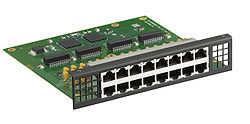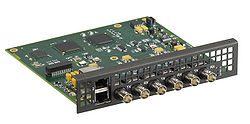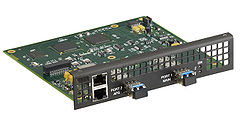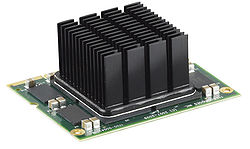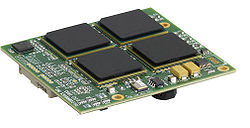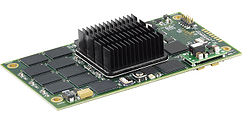Mezzanines
TelcoBridges has designed its Tmedia and Tdev systems to be highly modular in nature. Each device combines a motherboard providing core system functionality, including custom-designed FPGAs, with a series of mezzanine cards. These mezzanine cards, or modules, provide the different network interface types as well as VOIP and digital signal processing capabilities, which are useful for tone detection and IVR.
These modules can be mixed and matched at the time of purchase according to specific customer requirements; they can also be upgraded later on in the field. In fact, in many cases they can be upgraded via software license.
Contents |
Mezzanine types
- TDM
- Ethernet
- VOIP
- IVR
- CPU
Connectivity
TDM
With respect to TDM connectivity, TelcoBridges has designed three types of mezzanines, covering T1/E1/J1 interfaces; DS-3 interfaces; or optical/electrical STM-1 interfaces. (Please note that this does not apply to the Tmedia TMG800 or the Tdev TMP800 devices, both of which come with 8 physical T1/E1/J1 interfaces pre-installed.)Regarding T1/E1/J1 connectivity, there are two mezzanine options available. The one you choose will depend mostly on the system capacity you expect to require over time. The first option is a mezzanine featuring a total of 16 RJ-45 interfaces. The second option is a mezzanine containing two SCSI-2 ports that can be connected to two separate patch panels featuring 32 RJ-45 connectors each, for a total of 64 T1/E1/J1 interfaces in all. In both cases, it is possible to have full installed capacity up to the 16 or 64 interfaces per respective mezzanine option, but to be able to access only a sub-set of those interfaces initially. Using software licenses, additional interfaces can be activated. It is worth pointing out that these T1/E1/J1 interfaces are individually configurable using the Toolpack Web Portal. For example, if you have a total of 16 interfaces active, you can configure 7 of them for E1 connectivity and 9 of them for T1 connectivity, or any combination that you choose. This holds true for the entire 64 T1/E1/J1 interfaces.
The second type of TDM network mezzanine features DS-3 interfaces. While each module ships with a total of 3 DS-3 interfaces installed (using 6 female BNC connectors), it is possible to have as little as 1 or 2 DS-3 interfaces active at the time of purchase, and to then upgrade to the full 3 DS-3 interfaces via software license upgrades.
The third mezzanine offering for TDM connectivity is based on a single STM-1 connection, and can be purchased using either optical or electrical connectors. TelcoBridges’ implementation of STM-1 provides support for Automatic Protection Switching.
Ethernet
Ethernet connectivity is supported in three places.
The first is at the level of the wide area network (or WAN), which in most cases is a private IP network used for the purposes of delivering VOIP traffic, though it may also be the public Internet. Every Tmedia and Tdev device features dual 100/1000 Base-T Ethernet RJ-45 interfaces. This allows you to connect Tmedia or Tdev devices to two different private IP networks, one private IP network and the public internet, or 2 connections to the public internet via different service providers for redundancy purposes. The WAN ports are also used to communicate with TelcoBridges’ H.323 Signaling Converter, which converts between SIP and H.323 signaling.
The second Ethernet interface category is the control port, which is used by the Toolpack Engine to tell the media gateway or telecom platform what to do. The control port is present on all devices, though in the case of Tmedia devices such as the TMG800, TMG3200 and TMG5800, the active control ports are located within the device; those visible on the exterior of the TMG3200 and TMG5800 are not enabled. This is because Tmedia devices contain internal application hosts. For Tdev devices, the control port is located on the rear of the device beside the WAN (or VOIP) ports. An external application host is then connected via TCP/IP.
A third category of Ethernet interface, known as a management port, is provided in the case of the Tmedia devices. It is used to first configure an IP address on those devices and then to access the Toolpack Web Portal which resides within them. It also comes into play for communicating with an H.248-compliant softswitch residing on another device. For Tdev devices, management is provided by the host server running the Toolpack application.
A fourth type of port, known as a TMS port, is present on a number of Tdev or Tmedia devices. While it uses a RJ-45 interface like the Ethernet ports, it does not use Ethernet as such. Instead it features a proprietary, TDM-based transmission protocol that is used to connect multiple systems together to act as one from a TDM switching perspective. These TMS ports are used in the TMG7800 and TMP7900 devices, though they may also be used with mid-range media gateways and development platforms such as the TMG3200 and the TMP6400. TMS ports also provide clocking functionality among component devices.
VOIP
VOIP transcoding capabilities on TelcoBridges media gateway and telecom platform devices are provided by dedicated VOIP mezzanines. These support a variety of industry standards. These include:
- Universal audio Voice codecs such as G.711, G723.1, G.726, G.729ab, and T.38, which do not require a separate software license
- Optional audio codecs, such as AMR, AMR-WB (G.722.2), GSM-FR/GSM-EFR, EVRC/QCELP, G.728, G729eg, and iLBC, which do require a separate software license
- Fax Support, such as T.38 fax relay, Group 3 Fax/modem bypass, and G.711 fax fallback, which do not require a separate software license
TelcoBridges’ VOIP mezzanines feature dedicated VOIP chips. Whereas some competing media gateway and telecom development platforms use DSPs to perform transcoding, TelcoBridges offers a more cost-effective, resource-efficient solution that allows DSP modules to be applied to what they do best (i.e., functions such as tone-detection and IVR), and dedicated VOIP resources to be applied to what they do best. This means that it is possible to manage more simultaneous VOIP channels, while offering better performance (128ms of processing time for every channel used, irrespective of codec and number of active channels) and providing full Echo cancellation. In addition, the VOIP mezzanines are designed to be able to offer dynamic codec selection on a channel by channel basis, maintaining full channel availability even when using some of the more demanding codecs.
From a physical form factor perspective, there are four slots available on the motherboard for VOIP mezzanines. Each mezzanine can contain anywhere from 1 to 4 VOIP chips, for a potential 16 VOIP chips. Operational VOIP channel capacity up to the total physical channel capacity is possible in many cases via a software upgrade. However, depending upon the number of VOIP chips and/or VOIP mezzanines that were ordered at the time of purchase, it may be necessary to replace a given mezzanine in order to attain higher channel capacity.
Potential VOIP channel capacity varies depending upon both the model of media gateway or development platform as well as the audio codec being used. Some codecs are more resource intensive than others. TelcoBridges therefore expresses VOIP capacity in terms of universal voice channels, where there is largely a one-to-one ratio relative to TDM channel capacity.
- In the case of the entry-level TMG800 VOIP gateway and the TMP800 development platform, that limit is a total of 256 Universal voice channels, with upgrades available in increments of 32 VOIP channels at a time.
- For the mid-range TMG3200 and TMG5800 media gateways, as well as the TMP5900 and TMP6400 development platforms, the total channel capacity is 2048 universal voice channels, with upgrades available in increments of 256 VOIP channels at a time.
- Finally, for the cabinet-sized TMG7800 and TMP7900 devices, total channel capacity can be as high as 32,768 in all, with upgrades available in increments of 8192 channels at a time.
To simplify the calculation of system requirements, TelcoBridges has developed an online wizard that allows you to specify the desired number of VOIP channels on a codec by codec basis. This will then calculate the total required number of VOIP chips, which will then determine the number of VOIP mezzanines required. You can also use the same tool to calculate codec possibilities based on installed VOIP chip capacity.
IVR / DSP
While DSPs are absolutely necessary for providing any kind of interactive voice response (or IVR) capabilities, they can also optionally be used for providing such basic capabilities as DTMF tone detection, generation, and suppression as well as the detection of T.30 faxes. For more advanced value-added services such as ringback tones or voice mail, DSPs provide the ability to play back and/or record audio streams. Finally, the DSP mezzanine is used in the context of voice conferencing, where it can provide functions such as voice activity detection (VAD) and comfort noise generation (CNG). From a physical form factor perspective, there is a single slot on the motherboard for a DSP mezzanine. The DSP mezzanine itself can contain anywhere from 1 to 4 DSP chips. Operational DSP channel capacity up to the total physical channel capacity is possible in many cases via a software upgrade. However, depending upon the number of DSP chips that were ordered at the time of purchase, it may be necessary to replace an installed DSP mezzanine in order to attain higher channel capacity.
The theoretical DSP channel capacity varies according to the model of VOIP gateway or development platform. In the case of the entry-level TMG800 VOIP gateway and the TMP800 development platform, that limit is a total of 256 channels, with upgrades available in increments of 32 IVR channels at a time. For the mid-range TMG3200 and TMG5800 VOIP gateways, as well as the TMP5900 and TMP6400 development platforms, the total channel capacity is 2048 IVR channels, with upgrades available in increments of 128 IVR channels at a time. Finally, for the cabinet-sized TMG7800 and TMP7900 devices, total IVR channel capacity can be as high as 32,768 in all, with upgrades available in increments of 2048 channels at a time.
CPU
This option concerns most members of the Tmedia family of VOIP gateway devices, as well as the Tdev TMP5900 and TMP7900 development platforms. The Tdev TMP800 and TMP6400 both use external application hosts.
The TMG800 and TMG3200 both feature a CPU located on a mezzanine card. The CPU mezzanine contains a low-powered processor with a light-weight embedded operating system. This provides for very efficient power management for a given level of calls-per-second performance. As you know, calls-per-second performance is really unique to each specific deployment scenario.
The Tmedia TMG5800 and TMG7800 as well as the Tdev TMP5900 and TMP7900 use multi-core processors located on separate motherboards, meaning that the media gateway hardware that provides the transcoding and IVR capabilities is on one motherboard (via mezzanines), while the application host is run from a second motherboard. These two different types of motherboards are contained within the same form factor and are connected together via a LAN connection.
